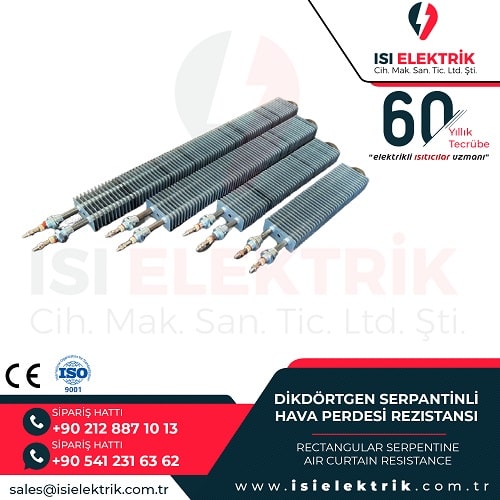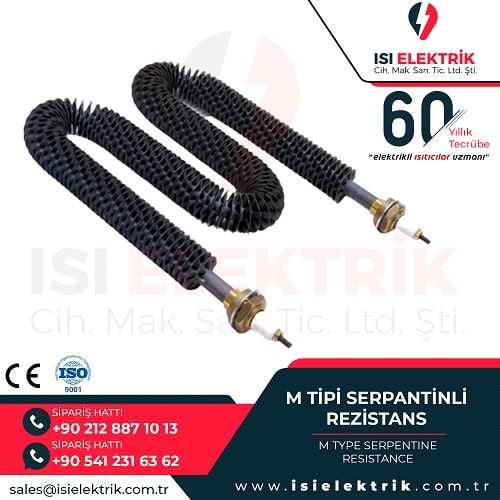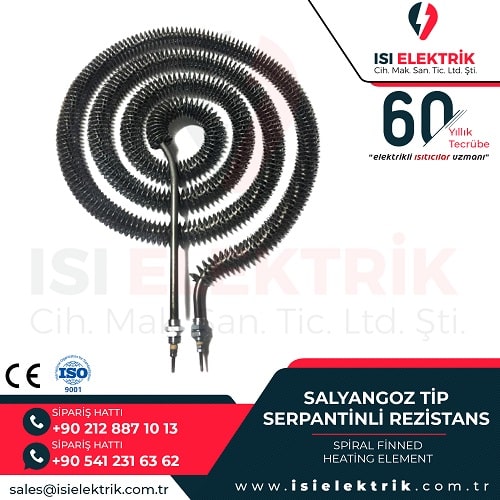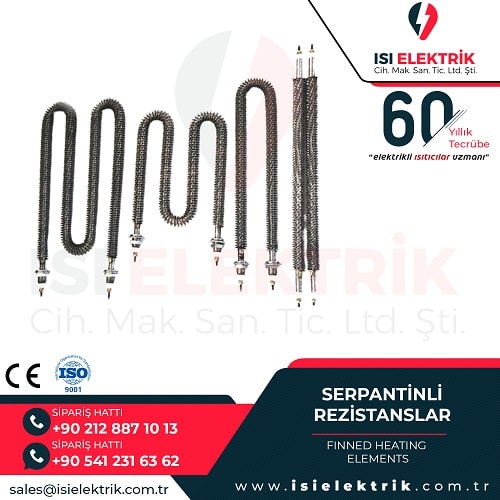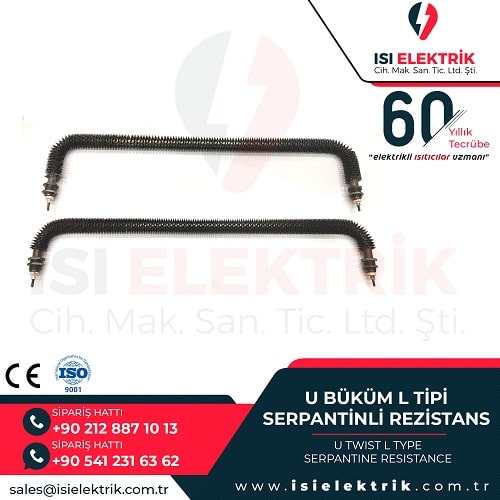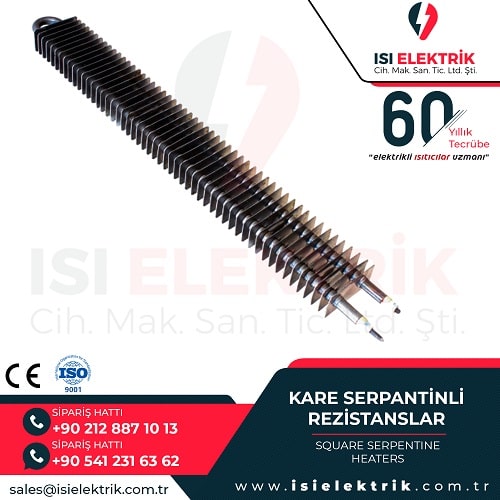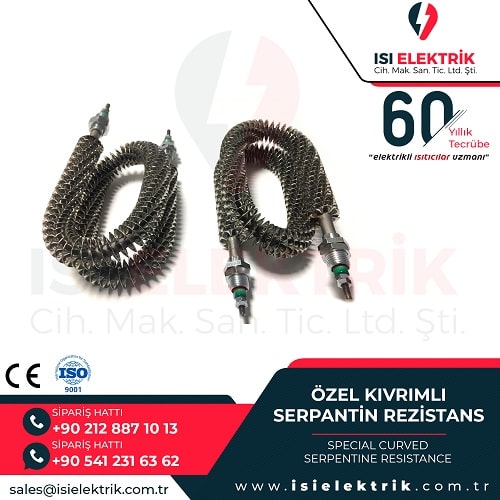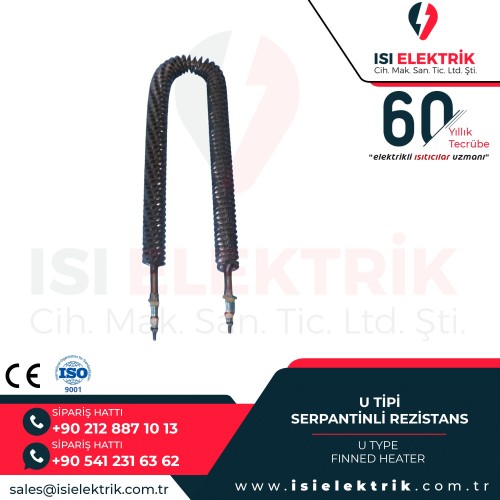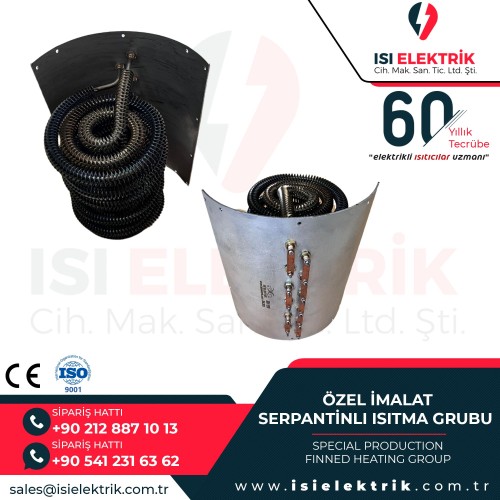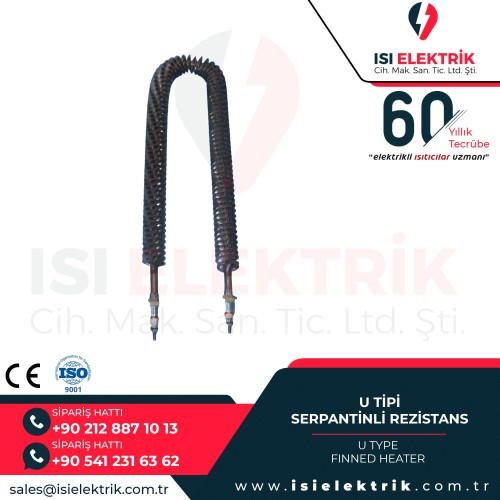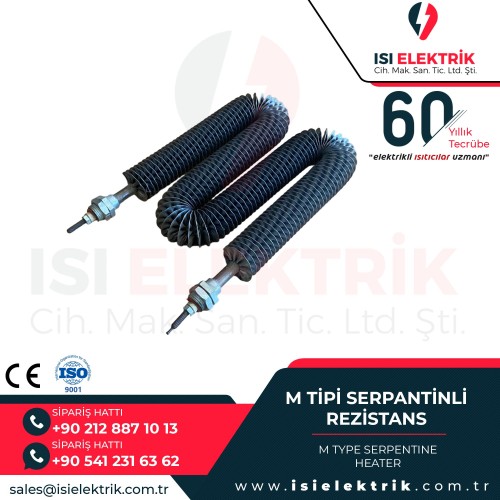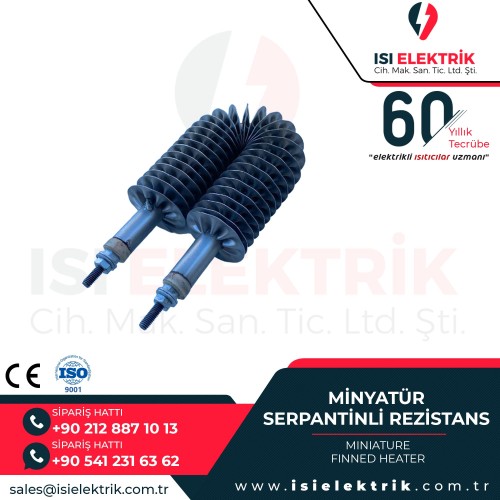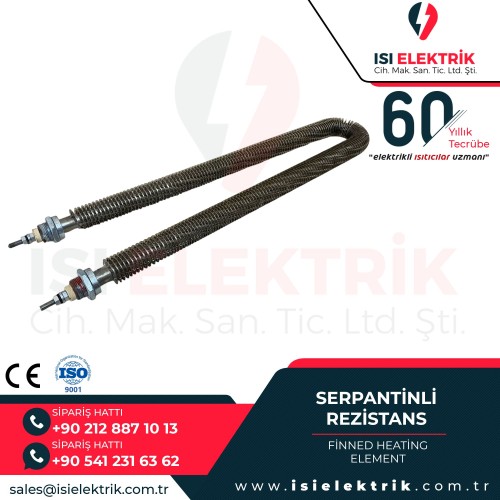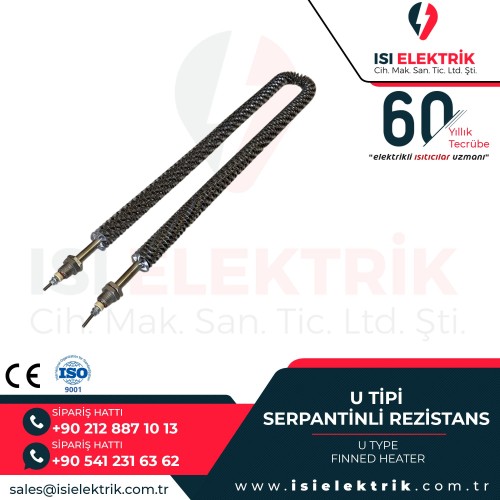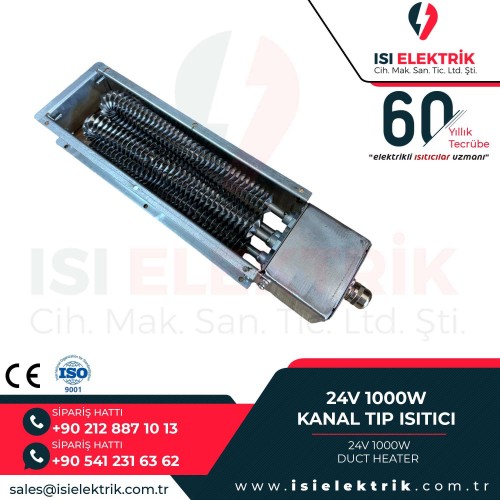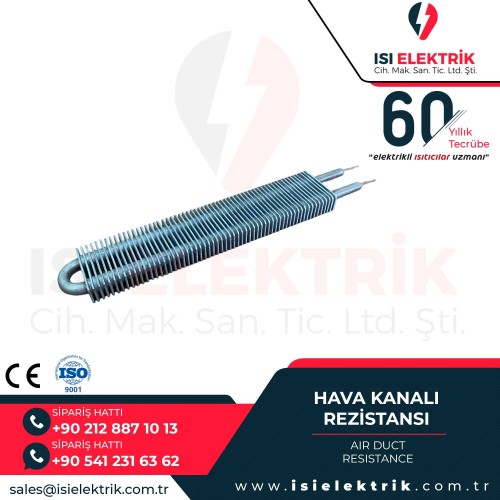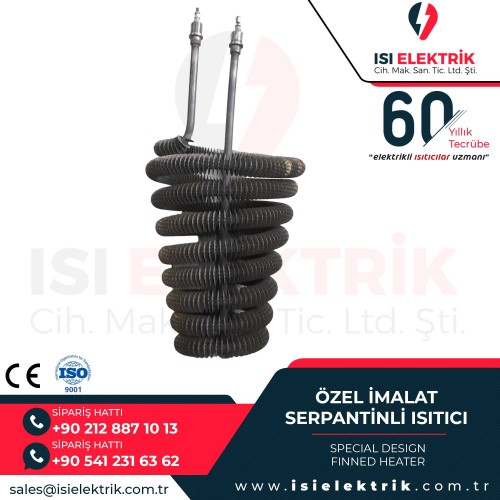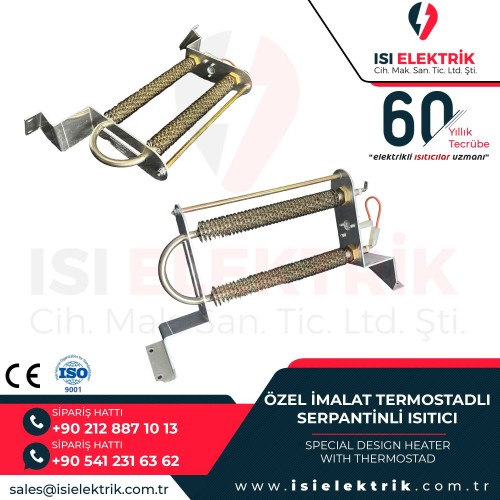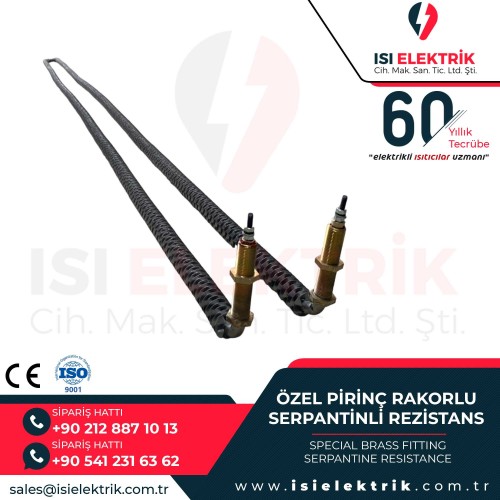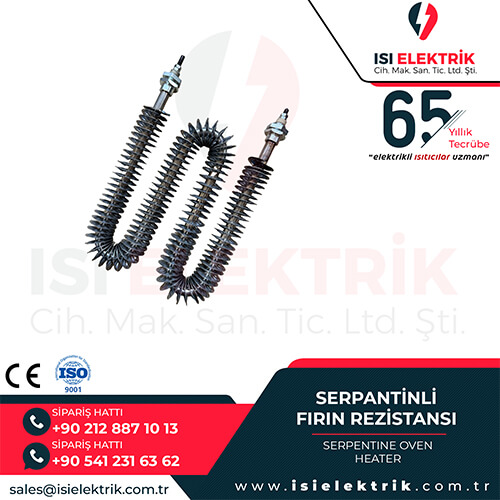Spiral Heaters
Spiral heaters are electric heating elements produced in coiled and spiral shapes. These heaters are typically made from one or two different alloys, chosen for their ability to withstand high temperatures and efficiently transfer heat. They are designed with cylindrical coils made from resistance wires, and they are capable of providing high-quality heat transfer on the surfaces of heaters. For this purpose, they can be used in Cr-Ni pipes to ensure effective heat transfer.
Spiral heaters are commonly made from one or two different alloys. The alloys typically used, such as Cr-Ni (Chromium-Nickel), are highly resistant to high temperatures, making them highly effective in heat transfer. These heaters are designed with cylindrical coils and resistance wires, which help to distribute heat efficiently across the heating surface, increasing overall performance.
Spiral heaters can perform effectively in applications that use Cr-Ni pipes, which are designed for heat transfer. These pipes are highly durable and can operate safely even at high temperatures. These heaters are particularly preferred in industrial applications that require high-temperature heating systems.
Spiral heaters can be produced in various types based on their intended use, and each type offers different functional features. For example, adding fittings (raccords) to heater heads makes the installation process faster and easier. This feature not only simplifies the installation but also improves the overall efficiency of the system.
These heaters collect the heat generated on their surface and transfer it to the desired area or location. Designed with CR-Ni and DKP materials, these heaters feature leaf and coil designs that promote efficient heat distribution. These designs help spread the heat over a larger surface area, allowing for the heating of a broader space.
Spiral heaters are used very efficiently in heating systems because they are highly resistant to temperature changes and have a high heat transfer capacity. This makes them ideal for large-scale heating processes, especially in industrial settings. In addition, their high-temperature durability and long-lasting performance reduce maintenance costs and increase the overall efficiency of the system.
Thanks to the high-quality materials used in their design, spiral heaters provide long-lasting and safe heating, making them a popular choice in industrial applications. They are not only used in industrial fields but are also effective in various laboratory and specialized applications. These heaters provide long-term economic benefits due to their high performance and durability.
Finned Heaters are available for purchase from our company. We manufacture in the size and features that you require. We can also help you with spare parts and maintenance issues. You can contact us for both personal and industrial needs.
What are the Usage Areas of Serpentine Heater?
Finned Heater is one of the products with numerous fields. These items are most frequently found in industrial furnaces. At the same time, they are used in blowing systems with fans and in the textile industry in fixing machines that provide steam to the yarns. Furthermore, the heater in paint drying ovens is serpentine. In conclusion, finned heaters should be used in all industrial areas where heat and steam are required for high efficiency and low consumption
In addition, it is also used in buildings and shopping malls serving in the construction sector. It can also be used to heat the air that comes out of air ducts in buildings like hospitals and hotels. It is used in all process systems in which drying is performed in the industrial field, depending on the environment. We create a special finned heater to meet your needs and provide you with unique solutions.
Finned Heaters Technical Specifications
• These heaters are produced in different diameters and powers.
• The standard tube diameter of the finned heaters is
between 6.5 and 20 mm in any size you want.
• Serpentine diameter varies between 20
mm and 50 mm depending on the tube
diameter.
• These heaters can
have a supply voltage between 24 V power and 500 V power.
• The coil and tubing material are chosen based on the
location, need, and area where the heater will be used.
• In environments with high-temperature, 310 S and Alloy
800 and Alloy 600 stainless tubes are used.
• If it is to be used in corrosive environments, 316 L
and Alloy 825 materials can be used.
• Finned heaters can reach up to 750 degrees of surface
temperature.
• Finned Heaters can be produced in shapes of U type, M
type, flat, round, and spiral.
• These heaters are generally produced from Cr-Ni tubes or cables. We also manufacture materials such as DKP tubes and copper tubes according to your needs.
How To Select Finned Heaters?
The finned heater you choose depends on the purpose of your use and the area in which you will use it. First, you must determine the product's strength, diameter, and size. At the same time, the ease of installation is considered according to the area you will use.
The device's shape and size should also be carefully chosen. You can
also take advantage of our energy-saving model consulting service. Staggered
mounting should be used in areas where air heating will be accomplished using a
fan. At the same time, U-type finned heaters are subjected to air friction in
these areas. This significantly improves heating performance.
If you intend to purchase a finned heater, please contact our team as soon as possible so that we can provide you with consultation and discovery services. We manufacture finned heaters in a very short period, with varying power, features, materials, and mounting options to meet any requirement.
Finned Heater Prices
Finned Heater prices vary depending on a variety of factors such as product material, power, mounting type, and diameter. These products perform well in any situation where there is a need for immediate heat. Serpentine heaters are significant for their energy efficiency as well as heating performance. If you want to learn more about these products, please contact us right now.
Contact us now to produce heaters with the features you want. At the
same time, get a price offer now. After our discovery service, we produce finned
heaters of all sizes and features according to your needs.
Types of Serpentine Heaters
- Flexible Serpentine Resistors: Designed with a flexible structure to adapt to curved surfaces, especially used for heating complex shapes.
- Coil Serpentine Resistors: Coiled in a spiral shape, typically used in industrial furnaces or ovens.
- High-Temperature Serpentine Resistors: Made from special alloys with high temperature tolerance, used in applications requiring very high temperatures such as glass melting furnaces or metal melting processes.
- Immersion Serpentine Resistors: Submerged in liquids for use, commonly used in water heaters, oil heaters, and chemical processes.
- Stainless Steel Serpentine Resistors: Made from stainless steel and corrosion-resistant, widely used in hygienic environments and the food industry.
Technical Specifications of Serpentine Heaters
- Basic Features:
- Power Range: Various power levels ranging from 500 Watts to 3000 Watts.
- Electrical Voltage: 220 Volts or 240 Volts.
- Temperature Range: Can be used in different temperature ranges from 50°C to 500°C.
- Material Options: Various body materials available such as stainless steel, aluminum, or cast iron.
- Heating Element Material: Heating elements can be made from various materials like nickel-chromium, stainless steel, or Inconel.
- Protection Class: Available in different protection classes like IP20, IP44, or IP65.
- Connection Types: Various connection options such as butterfly nut, cable connection, or plug connection.
- Additional Technical Details:
- Heating Rate: The resistor's ability to heat up quickly.
- Cooling Rate: The resistor's ability to cool down quickly.
- Heat Distribution: How the resistor distributes heat in a homogeneous manner.
- Lifespan: The durability of the resistor over time.
Applications of Serpentine Heaters
- Maritime Industry: Used in water heating systems for marine vessels, heating systems in ship cabins, and other maritime applications.
- Agricultural Industry: Utilized in greenhouse heating systems, hot water tanks, and irrigation systems in the agricultural sector.
- Aviation Industry: Found in aircraft and other air vehicles for cabin heating systems, engine heating systems, and other aviation applications.
- Swimming Pool Industry: Used for heating water in swimming pools to provide a comfortable swimming environment.
- Metallurgical Industry: Employed in metal melting furnaces, foundries, and other metal processing facilities for heating and melting processes.
- Medical Industry: Used for sterilization processes in medical devices, heating processes in laboratory equipment, and other medical applications.
- Energy Production: Utilized for heating in thermal energy production facilities, steam generators, boilers, and other energy production equipment.
Advantages of Serpentine Heaters
- Homogeneous Heat Distribution: Serpentine resistors generally distribute heat in a homogeneous manner, ensuring even temperature distribution in processes or heating areas.
- High Temperature Resistance: Many serpentine resistor materials are resistant to high temperatures, allowing them to be safely used in applications requiring high temperatures.
- Flexible Design Options: Serpentine resistors can be produced in different material types, sizes, and shapes, offering solutions suitable for various application needs.
- Stable Performance: High-quality serpentine resistors provide stable performance over time and do not experience significant decreases in heat production or efficiency over time.
- Safety: When properly designed and used, serpentine resistors can be operated safely, and automatic safety measures come into play in cases of overheating.
- Controllability: Serpentine resistors generally have controllable features, allowing temperature, current, and other parameters to be adjusted to desired levels.
Serpentine Heaters: Features Providing High Heat Efficiency
- Low Heat Loss: Serpentine heaters minimize heat loss due to their low thermal conductivity coefficient. This feature reduces energy consumption, ensuring more efficient heating and long-term energy savings.
- High Heat Transfer Capacity: The Serpentine design allows heat to spread over a larger area. This ensures more efficient heat distribution and supports the effective operation of the heater.
- Fast Heating: Serpentine heaters have the ability to transfer heat quickly, which ensures rapid heating. This feature increases energy efficiency and allows for quick and effective heating operations.
- Long Service Life: Serpentine heaters are made from durable alloys like Cr-Ni, allowing them to withstand high-temperature conditions for extended periods. This ensures long-term durability and reduces maintenance requirements.
- High Heat Resistance: Serpentine heaters are made from heat-resistant materials, enabling them to operate effectively in high-temperature environments for prolonged periods. This makes them ideal for applications with high heat demands.
Serpentine Heating Elements Technical Details
- Structure and Design: Serpentine heating elements are heating components produced in a spiral form, specifically designed to efficiently transfer heat by distributing it over a larger surface area. Typically made from Cr-Ni alloys, these elements are highly resistant to high temperatures and are ideal for long-lasting use. Their design ensures a more homogeneous distribution of heat on the heating surface, providing effective heat transfer.
- Working Principle: Serpentine heating elements generate heat when an electrical current passes through a conductor. The heat produced is transferred to the surrounding environment by spreading around the Serpentine-shaped tube or wire. This heat transfer process ensures that the heat is efficiently delivered to target areas. Heat is effectively maintained even under high-temperature conditions, typically using durable materials like CR-Ni (Chromium-Nickel) alloys.
- Insulation and Protection: Serpentine heating elements are coated with insulation materials that are resistant to high temperatures. These insulation layers protect against external factors and prevent energy loss. Additionally, special protection systems are included to minimize risks such as overheating or short circuits. This ensures safe operation and efficient heat transfer.
- Heat Distribution: One of the main advantages of serpentine heating elements is their ability to evenly distribute heat across a wide area. The spiral structure allows for effective heat conduction, providing more efficient results, especially in larger environments. The heat transfer spreads throughout the surroundings, ensuring the space heats up quickly and creating an efficient heating process.
- Durability and Long Life: Serpentine heating elements are made from durable alloys such as Cr-Ni. These alloys are highly resistant to high temperatures and external factors, ensuring that the product remains long-lasting and operates at high performance. These elements have a long service life, reducing maintenance and replacement costs.
- Easy Installation: Serpentine heating elements provide ease of installation for users. The addition of fittings to the heater heads accelerates the assembly process and makes it more practical. This facilitates quick installation, especially in industrial applications. Various installation options offer flexibility during system setup.
- Energy Efficiency: Serpentine heating elements stand out for their high-efficiency heat transfer capacity. The Serpentine design provides a larger surface area, allowing heat to spread more quickly and evenly. This feature reduces energy consumption, making the heating process more efficient. Additionally, these elements ensure high efficiency during long-term heating processes with lower energy consumption.
- Application Areas: Serpentine heating elements are widely used in industries with high-temperature requirements. They are effectively utilized in heating systems in industries such as plastic and rubber, electronics manufacturing, food processing, the automotive sector, and many more. They are also preferred in laboratories and areas with specialized heating needs.
Serpentine Heating Elements for Energy Saving
Serpentine heating elements play a crucial role in saving energy due to their high efficiency. These heating components distribute heat across a large surface area, enabling faster heating and more even temperature distribution. This feature allows for achieving the desired temperature with less energy consumption. In industrial applications, serpentine heating elements manage long heating processes effectively while consuming less power.
Serpentine heating elements are designed to minimize heat loss. High-quality materials and alloys with low thermal conductivity reduce energy loss to a minimum. As a result, higher performance can be achieved with less electricity. Additionally, the faster heating property ensures that the heating systems reach the desired temperature in a shorter time, further increasing energy efficiency.
Another factor contributing to energy saving is the high heat transfer capacity of serpentine heating elements. Heat is quickly spread around the metal spiral, ensuring that the heat is transferred to the environment more efficiently. As a result, energy is used more effectively, making these elements environmentally friendly and economically beneficial.
Technical Details to Consider When Choosing Serpentine Heating Elements
- Heat Resistance and Material Selection: Serpentine heating elements are made of materials that can withstand high temperatures. Therefore, choosing the right material is crucial. Alloys like Cr-Ni are highly resistant to high temperatures and are preferred in industrial applications. Additionally, material selection plays a critical role in the long lifespan of the heating element. It is important to choose serpentine heating elements made of materials that can endure both high temperatures and corrosion.
- Heat Transfer Capacity: The heat transfer capacity of serpentine heating elements is essential for efficient operation. The larger the surface area, the faster and more evenly the heat is distributed. Higher heat transfer capacity means the system works more efficiently and consumes less energy. Therefore, when choosing a serpentine heating element, it is important to select one with high heat transfer efficiency.
- Ease of Installation and Flexibility: Serpentine heating elements typically come with features that make installation easier. The addition of fittings and mounting accessories allows for faster and more practical installation. Also, different installation options and flexible designs make these elements suitable for various industrial applications. This ensures time and labor savings during the installation process.
- Energy Efficiency: Energy efficiency is another important factor when choosing serpentine heating elements. To achieve high performance with low energy consumption, it is necessary to choose the right model. Serpentine heating elements that effectively transfer heat and minimize energy losses provide a more efficient heating process, which translates to energy savings in the long term.
- Suitability for the Application Area: The right selection of serpentine heating elements depends on the specific application. Different designs and features may be required for industrial heating, plastic and rubber processing, food processing, and other areas. Choosing the appropriate model for each application will increase efficiency and provide long-lasting solutions.
Working Principle of Serpentine Heating Elements
Serpentine heating elements operate based on the principle of electrical resistance converting electrical energy into heat. When an electric current passes through the conductor, heat is generated due to resistance. This heat is then transferred to the surrounding environment through the spiral-shaped tube or wire. This process is known as Joule heating. The spiral design helps in spreading the heat quickly and efficiently across the surface, ensuring more effective heat transfer.
Another important feature in the working principle of serpentine heating elements is their ability to transfer heat efficiently. Heat is distributed across the surface of the serpentine heating element, typically made from high-temperature-resistant materials like CR-Ni alloys. This ensures that heat is spread evenly and that the desired temperature is reached more quickly, increasing energy efficiency and extending the lifespan of the system.
The working principle of serpentine heating elements allows for rapid and efficient heating, especially in larger areas. Heat is distributed across the entire surface of the element and transferred to the surrounding air, water, or other environments. This makes serpentine heating elements ideal for industrial applications where fast and efficient heating is needed for long periods, ensuring maximum energy savings and performance.
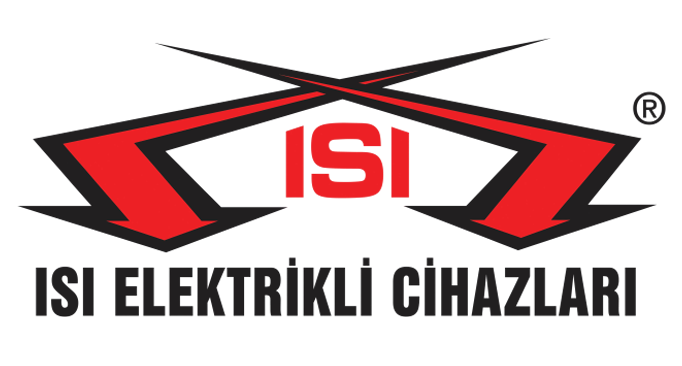
-500x500w.jpg)
-500x500w.jpg)
-500x500w.jpg)
-500x500w.jpg)
-500x500w.jpg)
-500x500w.jpg)
